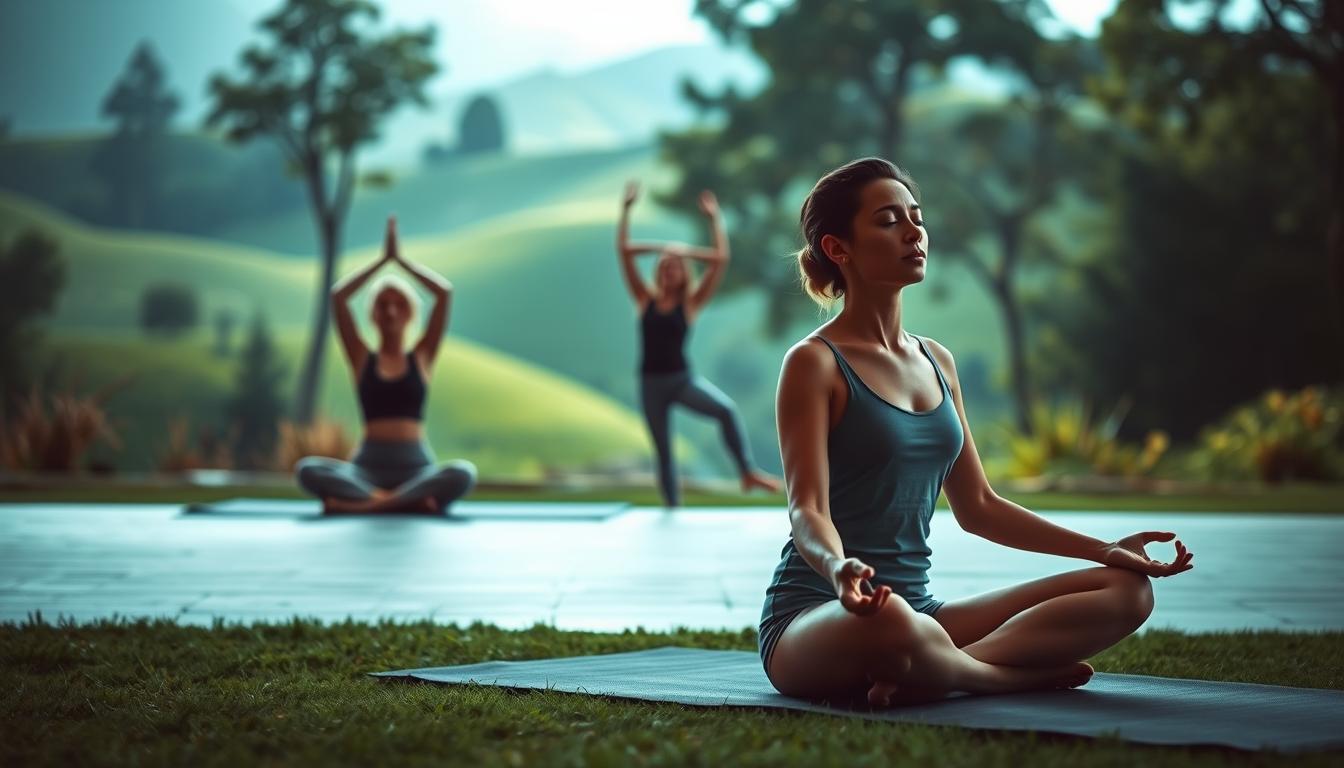Modern life moves fast, but science shows simple practices can help us slow down. Research from the Mayo Clinic reveals that consistent mindful habits may lower anxiety, sharpen focus, and even improve sleep patterns. Harvard studies reinforce these findings, showing structured awareness practices can ease emotional challenges as effectively as traditional methods.
Dr. Hemisha Patel Urgola, a clinical psychologist and founder of The Mindful Practice, explains: “Neuroscience proves these techniques physically reshape brain areas tied to decision-making and emotional balance.” This guide shares actionable methods rooted in this research, designed for real-world application.
You’ll learn adaptable approaches that fit seamlessly into workdays, commutes, or quiet evenings. Some methods take mere minutes yet deliver measurable stress relief. Others build lasting skills for managing overwhelming thoughts. All require no special tools or prior experience.
Key Takeaways
- Backed by Mayo Clinic and Harvard research for stress reduction
- Require only 2-10 minutes for noticeable impact
- Adaptable for home, office, or travel environments
- Support emotional balance and mental clarity
- Suitable for all experience levels
These evidence-based strategies help create pockets of peace amid chaos. Whether through breathwork or sensory awareness, each technique offers a path to reclaiming calm. Let’s explore how small daily practices can lead to big changes in how you navigate life’s pressures.
Introduction to Mindfulness and Stress Relief
Amidst the chaos of daily routines, cultivating awareness offers a refuge for the overwhelmed mind. This practice centers on observing your immediate experience without labeling things as “good” or “bad.” As Dr. Hemisha Patel Urgola puts it:
“Stepping outside of the clutter in your mind creates space for clearer thinking.”
Studies reveal fascinating biological impacts. Just 8 weeks of regular practice can shrink the amygdala (your brain’s stress center) while thickening areas linked to focus. This physical rewiring helps interrupt cycles of worry about tomorrow or frustration about yesterday.
Consider these comparisons between conventional approaches and mindful strategies:
| Traditional Stress Relief | Mindful Approach | Key Advantage |
|---|---|---|
| Medication | Breath awareness | No side effects |
| Weekend getaways | Sensory grounding | Available anytime |
| Therapy sessions | Body scans | Immediate application |
You don’t need special cushions or silent retreats. Washing dishes becomes a chance to feel warm water. Walking to meetings turns into sensory exploration – noticing footsteps and breeze. These micro-moments build resilience against life’s pressures.
By focusing on the present moment, you create a buffer between external chaos and internal calm. This skill strengthens mental health while reducing physical tension. Ready to explore practical ways to apply these principles?
Understanding Mindfulness: What It Is and Why It Matters
Living intentionally starts with recognizing how often we operate mechanically. Dr. Hemisha Patel Urgola warns: “If we go through life on autopilot, how many opportunities are we missing with people we love? That’s not living—that’s just existing.” This practice trains your attention to anchor in the now, creating space between stimuli and responses.
Mindfulness in Daily Life
You don’t need hours of meditation. Notice the warmth of your coffee mug during breakfast. Feel your feet connect with pavement during walks. These micro-moments of awareness build mental flexibility.
Research confirms that brief, consistent practice strengthens focus during routine tasks like emails or chores. Even folding laundry becomes a chance to observe textures and rhythms.
Scientific Benefits and Research Insights
Neuroimaging reveals tangible changes. Eight weeks of regular practice increases gray matter density in regions governing emotional control. Studies also show reduced amygdala activity—the brain’s panic button.
Universities like Harvard validate these findings. Their research proves present-moment focus reshapes neural pathways for lasting resilience. You’re not just calming down—you’re upgrading your biological stress response system.
Implementing 10 easy mindfulness exercises
Busy days demand tools that work wherever you are. These research-backed methods turn ordinary moments into opportunities for recentering. Dr. Urgola emphasizes: “Your breath and body hold immediate stress-relief potential—no apps or equipment required.”
Quick Mindful Breathing Techniques
Diaphragmatic breathing acts like a biological reset switch. Place one hand on your belly, inhale deeply through your nose for 4 seconds, then exhale slowly. This exercise triggers your relaxation response during tense work calls or crowded commutes.
Box breathing adds rhythm to your routine: Inhale (4 counts), hold (4), exhale (4), pause (4). The pattern helps regulate heart rate within minutes. “It’s like hitting pause on chaos,” explains Dr. Urgola.
Progressive Muscle Relaxation
Start by clenching your fists for 5 seconds, then release. Move through muscle groups from feet to forehead. This exercise reveals hidden tension you carry unconsciously. Many report feeling lighter after just one session.
Pair these methods with daily activities: Practice belly breathing while waiting for coffee. Try box breath patterns before emails. The key? Consistency over perfection.
Bringing Presence to Everyday Activities
Your daily routines hold hidden opportunities to reset your mental state. Dr. Hemisha Patel Urgola suggests: “The magic happens when you turn autopilot into active participation with your surroundings.” This approach transforms ordinary actions into grounding rituals that anchor you in the present moment.
Small Actions, Big Awareness
Consider these practical ways to infuse attention into your daily life:
- Toothbrushing becomes sensory exploration – notice minty freshness and bristle patterns
- Skincare routines turn tactile with focus on cream textures and citrus aromas
- Dishwashing transforms into water temperature awareness and soap bubble observation
Dr. Urgola shares her favorite method: “When applying moisturizer, I count seven slow breaths while feeling the product absorb. It creates instant calm before meetings.” This technique works because it combines physical sensation with rhythmic breathing.
The key lies in resisting mental distractions. Instead of planning your day during showers, feel water droplets on your shoulders. When walking to the mailbox, notice how your shoes connect with pavement. These micro-shifts in focus build mental resilience without adding extra activities to your schedule.
By viewing chores as chances for conscious engagement, you create multiple touchpoints for peace. Your commute becomes a study of changing landscapes. Folding laundry turns into a meditation on fabric textures. Each mindful choice strengthens your ability to stay centered amid life’s demands.
Mindfulness on the Move: Walking and Changing Your Environment
Movement creates natural opportunities to reconnect with your surroundings—a truth our bodies instinctively understand. Dr. Hemisha Patel Urgola notes: “Walking shifts energy patterns while grounding us through physical sensations.” This dual focus on motion and awareness makes it ideal for breaking mental loops.
Research shows brief outdoor sessions work like natural medicine. Spending moments in green spaces reduces cortisol levels by up to 15%, according to Environmental Health Perspectives studies. Try synchronizing your breath with footsteps during neighborhood strolls—inhale for three steps, exhale for four.
Clinical psychologist Ryan Howes recommends environmental resets when thoughts spiral. “Changing your visual field disrupts repetitive thinking patterns,” he explains. Even pacing through office corridors while noting floor textures can create mental space.
Focus on tactile details during movement:
- Pressure shifts between heel and toe
- Rhythm of arm swings
- Air temperature differences in shaded vs sunny areas
This practice turns commutes into discovery zones. Notice how light reflects off parked cars or how breeze carries distant sounds. Each observation anchors attention to the present, building resilience against stress triggers.
Combining gentle activity with sensory awareness offers double benefits—oxygenating your body while quieting mental chatter. Next time overwhelm strikes, let your feet guide you toward clarity.
Utilizing the Five Senses for Grounding
Your senses hold a secret weapon against stress – the ability to anchor you firmly in reality. When racing thoughts threaten to overwhelm, this biological toolkit brings immediate calm through simple observation.
How to Practice the 5-4-3-2-1 Exercise
Start by naming five things you can see – maybe sunlight patterns on walls or a coworker’s blue notebook. Next, identify four physical sensations: your watch’s weight, chair texture, or air moving through nostrils. This shifts focus from mental noise to bodily awareness.
Listen for three distinct sounds. Traffic hum, keyboard clicks, or distant laughter work equally well. Dr. Jennifer Wolkin explains: “This sensory input creates a protective barrier against intrusive thoughts.” Research confirms it lowers heart rates within 90 seconds.
Move to smell and taste – often the trickiest. Sniff your sleeve’s laundry scent or nearby coffee. Finally, notice lingering flavors from meals or toothpaste. Many discover hidden details in familiar environments through this exercise.
Clinical studies show this method works by engaging multiple brain regions simultaneously. The five senses become allies, redirecting attention from worries to concrete observations. Regular practice builds neural pathways that make calm responses automatic during stressful moments.
Keep it simple: Use waiting moments – elevator rides or microwave counts – to run through your senses. The more you practice noticing things see and feel, the faster you’ll regain control when tension rises.
Deep Breaths and Brief Meditation Sessions
Your breath holds an immediate reset button for racing thoughts. When stress hits, try this: Inhale slowly through your nose for four counts, then exhale for six. Deep breaths activate your body’s calming response faster than most realize. Dr. Urgola confirms: “This simple act tells your nervous system ‘danger has passed’ within minutes.”
For quick mental resets, set a timer for two minutes. Close your eyes and focus on air moving through your nostrils. If distractions arise, picture placing each thought on a leaf floating downstream. This visualization meditation creates distance from worries without judgment.
Research shows intentional breathing lowers heart rates 20% faster than passive relaxation. Your diaphragm’s movement directly signals safety to your brain. Pair this with grounding techniques – feel your feet pressing the floor or hands resting on your desk.
These methods work because they’re portable and adaptable. Use them before presentations, during commutes, or while waiting in line. Consistent deep breaths and micro-meditation sessions build lasting resilience against daily pressures.







